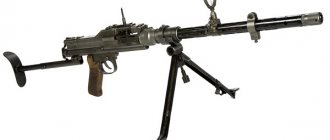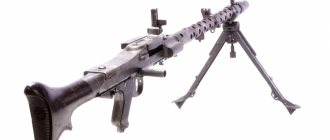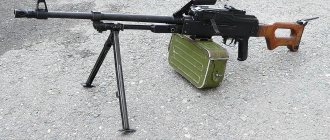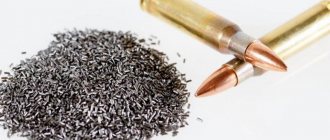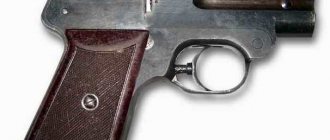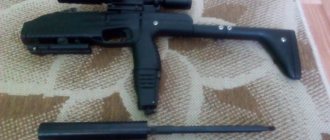Description of the weapon
The developers of the MG.42 had certain requirements: to make a very reliable and inexpensive to manufacture single machine gun, with the highest rate of fire, which would allow achieving the highest combat power. This machine gun used some elements of the MG.34, but we can say for sure that the MG.42 is an unusual and unique weapon.
Reduced price and manufacturability were achieved through the use of cool stamping and spot welding. So, for example, the receiver of a machine gun was made by stamping from a single blank, while for the MG.34 there were two separate milled parts.
The price of the new weapon decreased by approximately 30%, and metal consumption by 50%, the total number of parts decreased to 200 pieces. Apart from the bolt, muzzle, clamp and sear, all parts of this machine gun are stamped.
The MG.42 machine gun operates on the principle of recoil with a short stroke. Part of the powder gases is diverted through the muzzle device to enhance the recoil of the barrel after the shot. A special muzzle regulator allows you to change the recoil speed of the moving parts of the machine gun, thereby changing its rate of fire. The shot is fired with the shutter in the rear position (open shutter).
The cycle begins with cocking the bolt using a very large handle. After pressing the trigger, the bolt moves forward, sending the cartridge into the chamber. The barrel is locked using two rollers, which are located in the combat cylinder; they fit into special grooves in the breech. After they spread out, a firing pin passes between them and pierces the primer.
The rollers ensure smooth operation of the machine gun mechanics, greatly reduce friction, while providing sufficient support surface.
After the shot, the barrel, together with the bolt, moves backwards, the rollers in the combat cylinder are brought together by the bevels of the box. The barrel goes even further until it is pulled back by a return spring. A special spring-loaded ejector removes the cartridge case. The recoil spring pushes the bolt to the front position.
The impact mechanism of a striker-type machine gun is located in the bolt. The trigger mechanism is located in the pistol-type handle, and there is also a push-button safety that covers the trigger sear. The trigger mechanism on the MG.42 allows only automatic fire.
The sights of the machine gun consist of an open sight and a front sight. The folding front sight is mounted on the barrel casing, the sight is sectorial, has divisions from 200 to 2000 meters, with an interval of 100 meters. The sight clamp moved along the bar with a corresponding click, which made it possible to set the distance by ear, in conditions of poor visibility or in darkness.
The length of the aiming strip is 430 mm, and the sight slot is located at a significant distance from the back of the butt (550 mm). A fixed ring-type anti-aircraft sight can be attached to the machine gun casing.
The butt has the appropriate shape (“fish tail”), is located on the axis of the barrel, and can be held with the left hand when shooting from a bipod.
The barrel cools by air. The barrel casing has corresponding round holes, which improve heat loss, and on the right side there is a cutout for virtually the entire length of the barrel, through which it is replaced. The barrel is relatively light, it can be quickly changed; the process of replacing the barrel on the MG.42 takes 5-8 seconds.
Reducing the cost of production and increasing the rate of fire led to a decrease in the survivability of the barrel. Later, however, his channel began to be chromed, which somewhat improved the situation. Changing the barrel was not at all difficult and very comfortable: to do this, you had to push forward the latch, which was located on the right side of the casing. Then the barrel was pulled out backwards; one hand was enough to replace it. To carry out this operation, the machine gunner needed a glove or rag, since he needed to touch hot metal.
According to the rules, it was necessary to change the barrel every 150 shots (that’s three machine gun belts), otherwise the ballistic characteristics of the gun would decrease. Spare barrels were stored in a special container near the second number of the machine gun crew. Excessive overheating of the barrel could lead to jamming of the cartridge in the chamber.
A folding bipod was attached to the front part of the barrel casing, the design of which was slightly modified compared to the MG.34. The bipod had a hinged mount, which made it possible to put the machine gun on the ground and quickly raise it. The carrying strap was attached to the barrel casing and to the pistol grip.
The machine gun was powered by flexible iron belts with a semi-closed link, similar to the belt of the MG.34 machine gun. One tape could be attached to another using a cartridge. The length of one belt was 50 rounds. The problem with the machine gunners was the control of ammunition consumption, because the gun fired up to 20 rounds per second.
Loading a machine gun was very common. To do this, it was necessary to open the lid by pressing the convenient latch (this could be done with mittens), place the cartridge in the correct position and cock the bolt.
The high rate of fire of the machine gun determined the extensive use of the MG.42 as an anti-aircraft gun. This weapon was very often used as a light air defense weapon for infantry, also as an anti-aircraft machine gun for armored vehicles. Based on the MG.42, several anti-aircraft installations with several similar machine guns were created. In this case, they had a single trigger and special sighting devices.
For the MG.42, a special machine with 3 supports was developed: “Carriage-42”. It was somewhat different from the machine for MG.34, it was 3 kilograms lighter.
